Contents
New varieties of strawberries are bred by breeders every year. Dutch companies have long been the leading suppliers of promising varieties that invariably attract the attention of gardeners. Strawberry Florentina is one of the interesting varieties created in the Netherlands. The taste and appearance of the berries are definitely beyond praise. But this variety also has significant drawbacks.
History of breeding
Florentina is a strawberry variety bred in the Netherlands by breeders from Goossens Flevoplants’s. It became part of the Flevo Berry program, the goal of which is to obtain varieties of remontant strawberries that can become analogues and “competitors” of Elsanta, well-known to gardeners.
The variety, characterized by the creators as a “remontant for all occasions”, was bred in 2011. All the procedures necessary for certification in Our Country were completed in 2018. Strawberry Florentina is not included in the domestic State Register of Breeding Achievements.
Description and characteristics of the Florentina strawberry variety
Before planting Florentina strawberries, you need to carefully weigh the pros and cons. It has undeniable advantages, but it is not without serious shortcomings.
Appearance and taste of berries
Ripe Florentina strawberries are quite dark, red-burgundy in color. To the touch, the berry is rough due to the “convex” seeds. The skin is glossy, thin, but dense. Strawberries do not wrinkle when harvested. After the berry is plucked, it dries out a little more, which ensures good transportability.
The average weight of berries in the first “wave” of the harvest is about 30 g. In the second, it increases to 40-50 g. By the beginning of autumn, the berries become smaller again, becoming of different sizes (15-30 g).
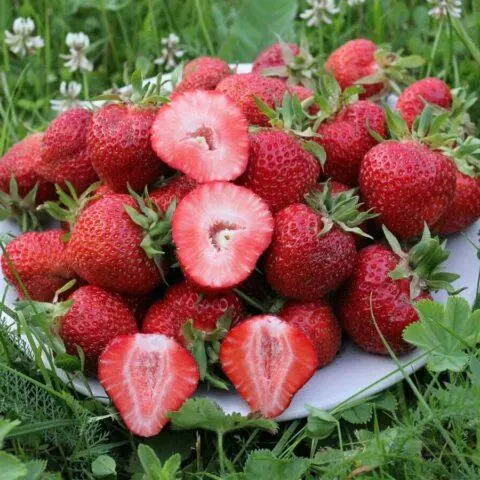
The shape does not change throughout the season – the berries resemble a “bloated” cone, large specimens can be slightly corrugated
The flesh of Florentina strawberries is bright red, very dense, not particularly juicy. The berries are extremely sweet, with a subtle refreshing sourness and a characteristic aroma, something between wild strawberries and pineapple. Such a balanced taste was rated 4,5 points out of five by professional tasters.
Flowering period, ripening period and yield
Strawberry Florentina belongs to the category of early remontant varieties. Its flowering in a temperate climate begins in the last decade of May. Further, generative buds are laid at intervals of 5-6 weeks, and this process is not affected by temperature fluctuations and daylight hours. It takes about 15 days for the berries to ripen.
The first harvest is taken in mid-June. Further, Florentina strawberries bear fruit until the end of September. And in the conditions in the south of Our Country – in general, until the first frost.
There are practically no empty flowers on plants. Therefore, under ideal conditions, according to breeders, an adult Florentina strawberry bush brings 4-5 kg of berries per season. But for amateur gardeners, these are absolutely fantastic indicators. Rather, you can count on 1,5-2,5 kg.
Strawberry Florentina belongs to the varieties of neutral daylight hours. This means that under the right conditions, plants are able to bear fruit throughout the year.
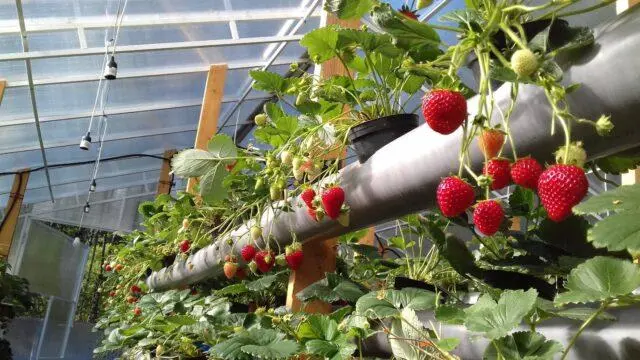
Florentina strawberries are well suited for commercial cultivation.
Frost resistance
Strawberry Florentina feels good at temperatures in the range of 2-30 ºС. But cold resistance within – 10 ºС does not allow her to winter in Our Country without careful shelter. Even in the southern subtropical regions, it is recommended to insure and protect plantings from frost.
Disease and pest resistance
The variety cannot boast of at least average immunity. Florentina strawberries are extremely susceptible to fungal diseases, especially various types of blotches and rots. Even regular preventive treatments with special preparations do not always help to avoid infection, especially if cool rainy weather favors the development of diseases for a long time.
Florentina also enjoys special “love” from garden pests. If there are several varieties of strawberries in the garden, it is her bushes that are attacked first.
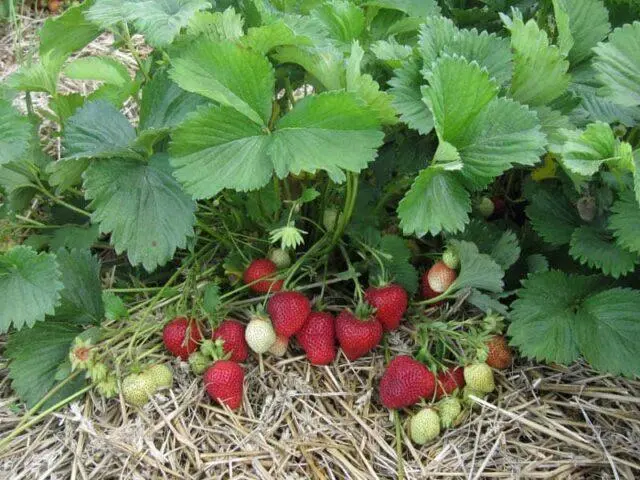
For unknown reasons, May beetle larvae feed a strong weakness for Florentina.
Pros and cons of the variety
The significant disadvantages of Florentina strawberries in the eyes of many gardeners “outweigh” its undoubted advantages.
Pros | Cons |
A powerful root system, thanks to which the seedlings quickly adapt to a new place, actively begin to grow | Propensity to be affected by diseases and pests |
Slight leafiness, facilitating the harvesting process | Susceptibility of berries and root system to decay in rainy weather
|
High yields in optimal conditions | Frost resistance not high enough for Our Country |
Possibility of year-round cultivation of berries | Relatively few whiskers formed |
Keeping quality (up to 5-7 days) and transportability of strawberries | Requirements for the quality of the substrate |
Attractive appearance and excellent taste of fruits, not lost during heat treatment and freezing | The need to carefully follow the recommendations regarding agricultural technology |
The versatility of the appointment of berries |
|
Planting and caring for Florentina strawberries
For landing, a flat, open place, well warmed by the sun, is suitable. But during the period of its maximum activity, strawberries should be covered with light penumbra. Required and the presence of protection from the north. Florentina does not tolerate cold drafts, sharp gusts of wind.
The soil needs nutritious, but relatively light, air and water permeable. Stagnation of moisture at the roots provokes the development of rot. Loam or sandy loam is best suited. Acid-base balance – neutral, 5.5-6.0.
This variety forms a mustache reluctantly; strawberries propagate mainly by dividing the bush. You need to choose an adult (2-3 years old), completely healthy plant, dig it out of the soil, carefully unravel the roots and divide it into parts so that at least one generative bud remains on each.
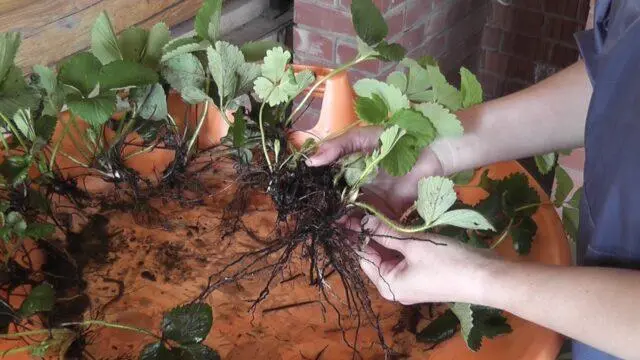
When dividing the bush, it is important not to damage the “solid” roots.
Florentina’s susceptibility to fungal diseases requires regular preventive treatments. The first is carried out even before planting, pickling the roots of seedlings in a solution of any fungicide for 15-20 minutes. Further, the treatment with copper-containing preparations is repeated at intervals of 1,5-2 weeks. Since strawberries are characterized by a long fruiting period, it is necessary to choose products of biological origin so that the berries and the health of those who will eat them do not suffer.
To repel insects, a garden bed with Florentina is surrounded by plantings of garlic, herbs, marigolds, and other plants with a pronounced aroma. Bushes are regularly inspected for pests. Noticing the characteristic symptoms, apply a suitable insecticide.
Florentina is fed with store-bought fertilizers designed specifically for strawberries. Only they, with such a high yield, are able to provide plants with the necessary amount of nutrients.
During the season, four top dressings are carried out:
- at the very beginning of the active growing season;
- when the first buds appear;
- after the first “wave” of the harvest;
- in the second decade of September.
Strawberry Florentina does not like both overdrying and waterlogging of the soil. Therefore, the frequency of watering varies depending on the weather. On average, once every 4-5 days is enough, the norm for an adult plant is about 3 liters. In the heat, the intervals are reduced to 2-3 days. Any method in which drops of water do not fall on leaves, buds and berries.
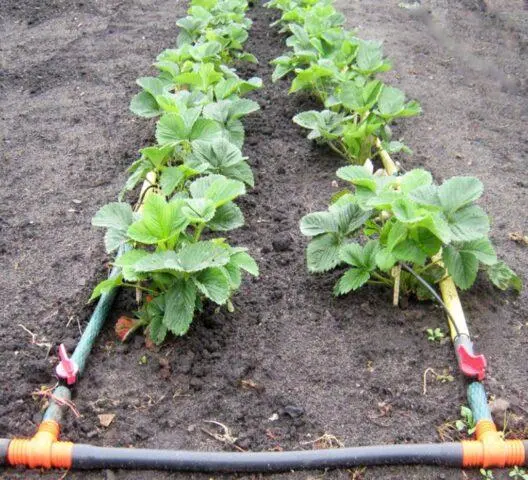
Strawberry Florentina is ideal for drip irrigation
In preparation for winter, the Florentina strawberry garden is cleared of plant and other debris. Peat or humus is poured to the roots of each bush, constructing “mounds” about 15 cm high. The entire garden is covered with spruce branches, dry grass, and fallen leaves. Low arcs are installed on top, any covering material is pulled over them in 2-3 layers. In winter, as soon as enough snow falls, the bed is thrown from above.
Conclusion
Strawberry Florentina is a variety that is extremely demanding in terms of agricultural technology, cultivation conditions, it is susceptible to diseases. Therefore, it can be recommended only to those gardeners who are ready to devote a lot of time and effort to caring for plants. This variety brings stable and plentiful harvests only in optimal or close to them conditions. Berries are the main advantage of Florentina strawberries.










